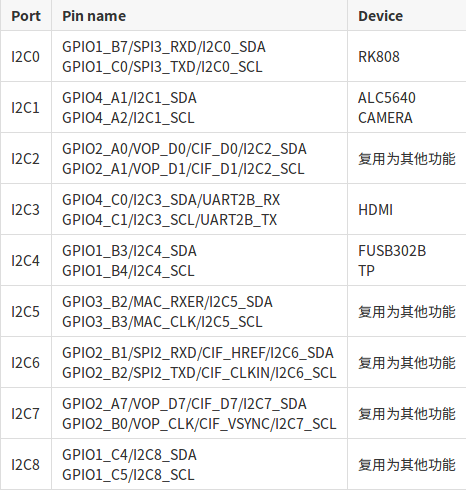I2C 使用
前言
AIO-3288J 开发板上有 6 个片上 I2C 控制器。本文主要描述如何在该开发板上配置 I2C。
配置 I2C 可分为两大步骤:
定义和注册 I2C 设备
定义和注册 I2C 驱动
下面以配置 lt8641ex 为例。
定义和注册 I2C 设备
在注册I2C设备时,需要结构体 i2c_client 来描述 I2C 设备。然而在标准Linux中,用户只需要提供相应的 I2C 设备信息,Linux就会根据所提供的信息构造 i2c_client 结构体。
用户所提供的 I2C 设备信息以节点的形式写到 dts 文件中,如下所示:
&i2c1 { status = "okay"; lt8641ex@3f { compatible = "firefly,lt8641ex"; gpio-sw = <&gpio7 GPIO_B2 GPIO_ACTIVE_LOW>; reg = <0x3f>; }; rtc@51 { compatible = "nxp,pcf8563"; reg = <0x51>; }; };
定义和注册 I2C 驱动
定义 I2C 驱动
在定义 I2C 驱动之前,用户首先要定义变量 of_device_id 和 i2c_device_id 。of_device_id 用于在驱动中调用dts文件中定义的设备信息,其定义如下所示:
static const struct of_device_id of_rk_lt8641ex_match[]={ { .compatible = "firefly,lt8641ex" }, { /* Sentinel */ } };
定义变量 i2c_device_id:
static const struct i2c_device_id lt8641ex_id[] = { { lt8641ex, 0 }, { } }; MODULE_DEVICE_TABLE(i2c, lt8641ex_id);
i2c_driver 如下所示:
static struct i2c_driver lt8641ex_device_driver = { .driver = { .name = "lt8641ex", .owner = THIS_MODULE, .of_match_table = of_rk_lt8641ex_match, }, .probe = lt8641ex_probe, .remove = lt8641ex_remove, .suspend = lt8641ex_suspend, .resume = lt8641ex_resume, .id_table = lt8641ex_id,};
注:变量id_table指示该驱动所支持的设备。
注册 I2C 驱动
使用i2c_add_driver函数注册 I2C 驱动。
i2c_add_driver(<8641ex_device_driver);
在调用 i2c_add_driver 注册 I2C 驱动时,会遍历 I2C 设备,如果该驱动支持所遍历到的设备,则会调用该驱动的 probe 函数。
通过 I2C 收发数据
在注册好 I2 C 驱动后,即可进行 I2C 通讯。
向从机发送信息
static int i2c_master_reg8_send(const struct i2c_client *client, const char reg, const char *buf, int count, int scl_rate) { struct i2c_adapter *adap=client->adapter; struct i2c_msg msg; int ret; char *tx_buf = (char *)kzalloc(count + 1, GFP_KERNEL); if(!tx_buf) return -ENOMEM; tx_buf[0] = reg; memcpy(tx_buf+1, buf, count); msg.addr = client->addr; msg.flags = client->flags; msg.len = count + 1; msg.buf = (char *)tx_buf; msg.scl_rate = scl_rate; ret = i2c_transfer(adap, &msg, 1); kfree(tx_buf); return (ret == 1) ? count : ret; }
向从机读取信息
static int i2c_master_reg8_recv(const struct i2c_client *client, const char reg, char *buf, int count, int scl_rate) { struct i2c_adapter *adap=client->adapter; struct i2c_msg msgs[2]; int ret; char reg_buf = reg; msgs[0].addr = client->addr; msgs[0].flags = client->flags; msgs[0].len = 1; msgs[0].buf = ®_buf; msgs[0].scl_rate = scl_rate; msgs[1].addr = client->addr; msgs[1].flags = client->flags | I2C_M_RD;msgs[1].len = count; msgs[1].buf = (char *)buf; msgs[1].scl_rate = scl_rate; ret = i2c_transfer(adap, msgs, 2); return (ret == 2)? count : ret; }
注:msgs[0] 是要向从机发送的信息,告诉从机主机要读取信息。msgs[1] 是主机向从机读取到的信息。
至此,主机可以使用函数 i2c_master_reg8_send 和 i2c_master_reg8_recv 和从机进行通讯。
实际通讯示例
例如主机和 LT8641EX 通讯,主机向 LT8641EX 发送信息,设置 LT8641EX 使用通道 1:
int channel=1; i2c_master_reg8_send(g_lt8641ex->client, 0x00, &channel,1, 100000);
注:通道寄存器的地址为0x00。 主机向从机 LT8641EX 读取当前使用的通道:
u8 ch = 0xfe; i2c_master_reg8_recv(g_lt8641ex->client, 0x00, &ch,1, 100000);
注:ch用于保存读取到的信息。
-
Linux
+关注
关注
87文章
11291浏览量
209305 -
嵌入式主板
+关注
关注
7文章
6085浏览量
35294 -
Firefly
+关注
关注
2文章
538浏览量
7026
发布评论请先 登录
相关推荐
英创信息技术JAVA操作英创主板I2C接口简介

fireflyAIO-3288J主板UART使用简介

fireflyAIO-3288J主板PWM输出简介
fireflyAIO-3288J主板MIPI CSI介绍

fireflyAIO-3288J方案

fireflyAIO-3288J红外遥控器介绍
fireflyAIO-3288J主板ADC使用简介
fireflyAIO-3288J主板启动模式介绍
硬件I2C与模拟I2C





 fireflyAIO-3288J主板I2C简介
fireflyAIO-3288J主板I2C简介














评论